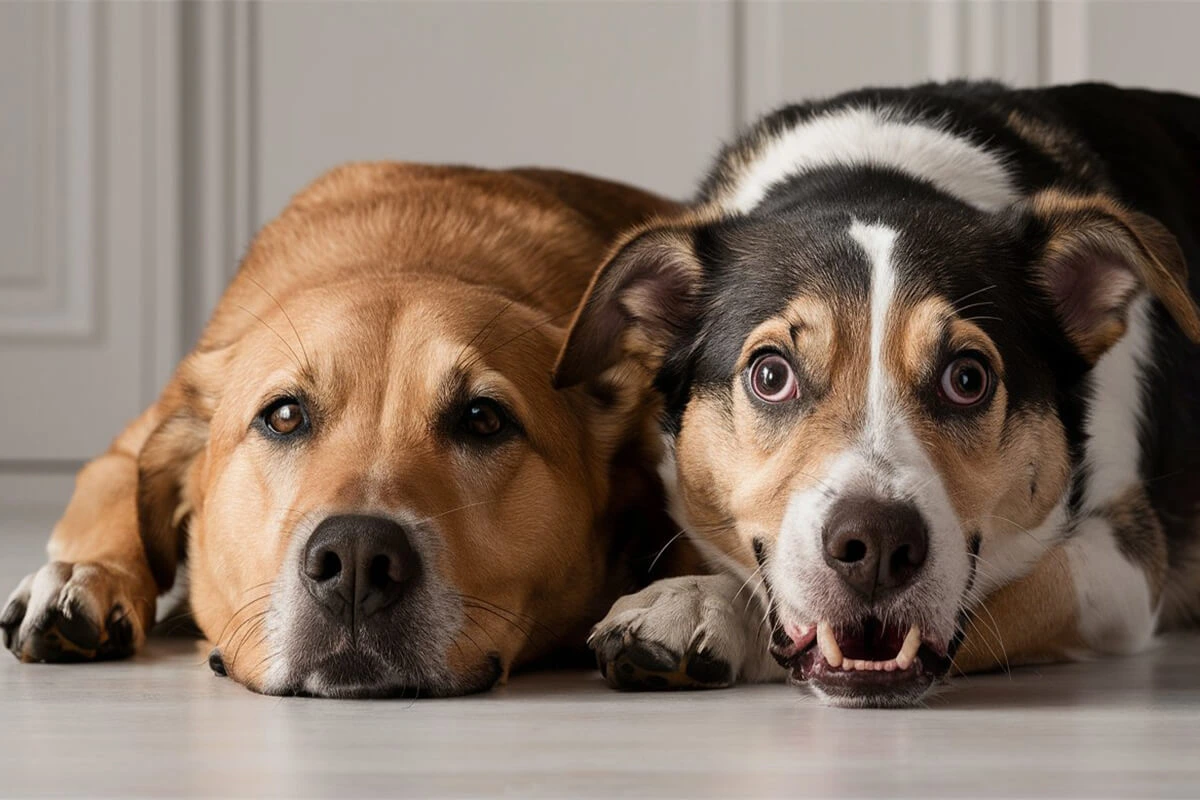Dogs pant for many reasons, and in most cases, it’s completely normal. They regulate their body temperature through panting, especially after exercise or during hot weather. However, when a dog starts breathing heavy for no clear reason, it can signal something more serious.
Heavy panting, rapid breathing, or labored breaths could point to an underlying health issue. Heatstroke, anxiety, respiratory infections, heart disease, or even an allergic reaction can all trigger abnormal breathing patterns. Some of these conditions require immediate veterinary attention, so pet owners must recognize the warning signs before it’s too late.
This article will help you understand why dogs breathe heavily, when to take action, and what urgent symptoms indicate an emergency. By learning these key signs, you can ensure your furry friend stays safe, comfortable, and healthy.
Understanding Why Your Dog is Breathing Heavy
Normal vs. Abnormal Breathing in Dogs
Dogs naturally breathe faster than humans, and dog breathing heavy plays a crucial role in their ability to regulate body temperature. Normal panting looks relaxed and rhythmic, with an open mouth and tongue hanging out. After exercise or during warm weather, panting helps them cool down by evaporating moisture from their tongue and respiratory tract.
However, abnormal breathing patterns stand out because they seem excessive, labored, or unrelated to physical exertion. A dog struggling to catch its breath, wheezing, or dog breathing heavy while at rest may have an underlying health issue. Other concerning signs include pale or blue gums, unusual body posture, and loud, raspy sounds when inhaling or exhaling. Pet owners should observe their dog’s breathing patterns closely and recognize when dog breathing heavy becomes a sign of distress.

Role of the Canine Respiratory System in Breathing
A dog’s respiratory system includes the nose, trachea, lungs, and diaphragm. Air enters through the nose or mouth, travels down the trachea, and reaches the lungs, where oxygen enters the bloodstream. The diaphragm, a muscle beneath the lungs, controls inhalation and exhalation by expanding and contracting.
Healthy dogs breathe smoothly, and their respiratory system efficiently delivers oxygen to the body. However, several factors can disrupt this process. Narrowed airways, lung infections, or heart conditions can reduce oxygen flow, forcing the dog to breathe faster or struggle for air. Short-nosed breeds, such as Bulldogs and Pugs, have naturally restricted airways, making them more prone to breathing difficulties. Understanding how a dog’s respiratory system works helps pet owners recognize when something interferes with normal breathing.
Common Reasons Why Dogs Pant Or Breathing Heavy
Panting serves several important functions beyond just cooling down. After exercise, dogs pant to release excess heat since they don’t sweat like humans. Excitement, stress, or anxiety can also trigger panting, as the body prepares to respond to heightened emotions. Some dogs pant when they feel scared, such as during thunderstorms, fireworks, or vet visits.
In some cases, panting happens because of pain or discomfort. Dogs experiencing internal pain, whether from injury, illness, or digestive issues, may pant more than usual. Certain medications, fever, or allergic reactions can also increase breathing rates. While panting is often harmless, pet owners should pay attention to when and why it happens to determine if it signals a problem.
Common Causes of Heavy Panting or breathing in Dogs
Heatstroke in Dogs
Dogs struggle to regulate their body temperature in extreme heat, making them highly vulnerable to heatstroke. Unlike humans, they do not sweat through their skin. Instead, they cool down by breathing fast and sweating through the pads of their paws. When temperatures rise too high or they overexert themselves, their bodies may fail to release enough heat, leading to dangerous overheating.
Heavy panting, excessive drooling, red gums, vomiting, and weakness often signal heatstroke. If their body temperature climbs above 104°F (40°C), they can suffer from organ failure, seizures, or even death. Dogs with thick fur, short noses, or existing health issues face a higher risk. Pet owners should always provide shade, fresh water, and limit outdoor activity during hot weather to prevent heat-related emergencies. If a dog shows signs of heatstroke, immediate cooling and emergency veterinary care can save its life.
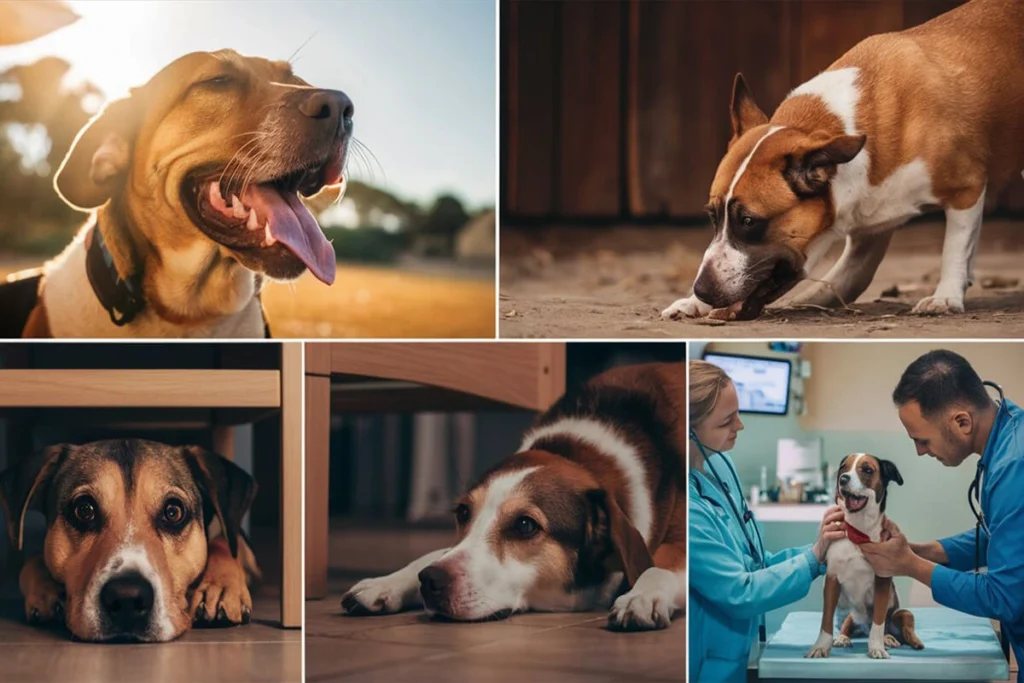
Brachycephalic Breeds and Breathing Difficulties
Short-nosed, or brachycephalic, breeds like Bulldogs, Pugs, and Boxers often struggle with breathing issues because of their facial structure. Their shortened skulls compress the airways, making it harder for them to breathe efficiently. Many of these breeds suffer from Brachycephalic Obstructive Airway Syndrome (BOAS), which causes chronic respiratory distress.
These dogs may pant excessively, snore loudly, or make wheezing noises even when resting. Hot weather, stress, or physical activity can make their breathing worse. Some may collapse or experience sudden breathing crises if their airways become completely blocked. Owners of brachycephalic dogs should keep them cool, avoid strenuous exercise, and monitor for signs of respiratory distress. In severe cases, surgery may help widen their airways and improve breathing.
Anxiety and Stress in Dogs
Just like humans, dogs experience anxiety and stress, which can lead to rapid breathing or heavy panting. Loud noises, separation from their owner, unfamiliar environments, or new experiences can trigger stress responses. When dogs feel anxious, their bodies release adrenaline, increasing their heart rate and breathing rate.
Signs of anxiety-related panting include restlessness, pacing, whining, or trembling. Some dogs may hide, refuse food, or seek constant reassurance from their owner. Chronic stress can weaken a dog’s immune system and lead to long-term health issues. Pet owners can help reduce anxiety by creating a calm environment, using positive reinforcement, and providing mental stimulation. In severe cases, a veterinarian may recommend behavioral training or anxiety-reducing supplements.
Allergies in Dogs
Allergies can cause more than just itching and skin irritation in dogs—they can also trigger respiratory problems. Dogs may develop allergies to pollen, dust mites, mold, certain foods, or insect bites. When exposed to allergens, their immune system overreacts, leading to inflammation in the airways.
Heavy panting, sneezing, coughing, and nasal discharge may indicate an allergic reaction affecting their breathing. Some dogs develop allergic bronchitis, which causes persistent wheezing and difficulty breathing. In rare cases, a severe allergic reaction called anaphylaxis can cause sudden airway swelling, making it impossible for the dog to breathe.
Owners should track possible allergens and minimize exposure to triggers. Antihistamines, allergy-friendly diets, and veterinary treatment can help manage symptoms and improve a dog’s breathing.
When Dog Heavy Breathing Indicates a Health Emergency
Dog Respiratory Distress
Respiratory distress in dogs happens when they struggle to breathe properly. Unlike normal panting, which helps regulate body temperature, respiratory distress often looks labored, irregular, or exaggerated. Dogs in distress may flare their nostrils, stretch their necks forward, or keep their mouths wide open in an attempt to get more air.
Several conditions can cause breathing difficulties, including lung disease, airway obstructions, and heart problems. Dogs experiencing respiratory distress may also show other warning signs, such as blue or pale gums, extreme fatigue, or loud wheezing sounds. If a dog appears to be gasping for air or cannot catch its breath, the situation requires immediate veterinary attention. Ignoring respiratory distress can lead to oxygen deprivation, organ damage, or even death.
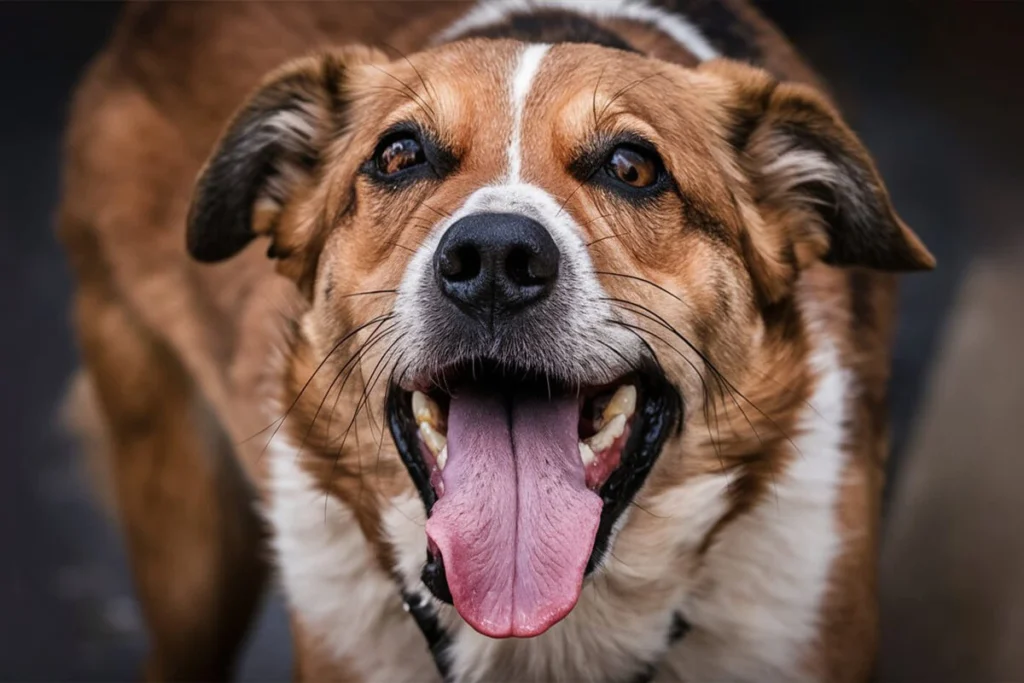
Heart Disease in Dogs
Heart disease affects a dog’s ability to pump oxygen-rich blood throughout the body. When the heart weakens or develops structural problems, fluid can build up in the lungs, making it harder for the dog to breathe. Congestive heart failure (CHF) is one of the most common heart conditions that lead to heavy breathing, coughing, and exercise intolerance.
Dogs with heart disease may pant excessively, breathe with difficulty, or show signs of fatigue after minimal activity. Some may develop swollen bellies due to fluid accumulation, and others may faint because of poor oxygen circulation. Senior dogs and certain breeds, such as Cavalier King Charles Spaniels and Doberman Pinschers, face a higher risk of heart disease. Pet owners should schedule regular vet checkups to monitor heart health and catch early warning signs before the condition worsens.
Respiratory Infections
Dogs can develop respiratory infections caused by bacteria, viruses, or fungi. These infections affect the lungs, throat, or nasal passages, leading to inflammation and breathing difficulties. Kennel cough, canine influenza, and pneumonia are some of the most common respiratory illnesses in dogs.
Dogs with respiratory infections may cough persistently, wheeze, or struggle to breathe. Some may develop nasal discharge, fever, or a loss of appetite. Puppies, senior dogs, and dogs with weakened immune systems have a higher risk of severe infections. If a dog shows signs of labored breathing or worsens over time, veterinary treatment becomes necessary. Vets may prescribe antibiotics, antiviral medications, or supportive care to help the dog recover. Preventative measures, such as vaccinations and avoiding exposure to sick dogs, can reduce the risk of respiratory infections.
Dog Breathing Fast While Resting
A dog breathing fast while resting can be a sign of an underlying health issue. While mild panting after playtime or excitement is normal, rapid breathing during rest may indicate pain, stress, fever, or a medical condition.
Pain from injuries, arthritis, or internal problems like bloat can cause dogs to breathe faster than usual. Fever from infections also increases breathing rates as the body tries to cool down. Additionally, stress and anxiety can make dogs breathe faster, even when they are lying down.
In more serious cases, rapid breathing at rest may signal heart disease, lung conditions, or anemia, which reduces the oxygen-carrying capacity of the blood. If a dog consistently breathes fast while resting, appears lethargic, or struggles to breathe, a veterinary examination can help determine the cause and necessary treatment.
What to Do If Your Dog Is Breathing Heavy
How to Check for Veterinary Emergency Signs
Recognizing emergency signs early can make the difference between life and death for a dog experiencing breathing difficulties. Pet owners should closely observe their dog’s breathing patterns and look for any unusual signs.
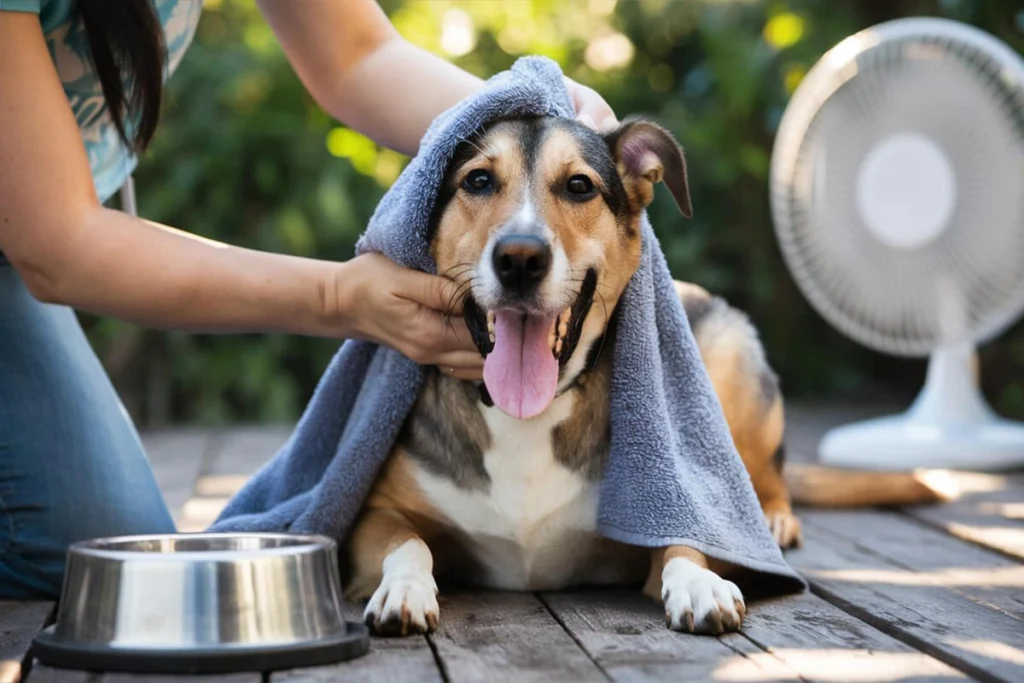
Signs of a veterinary emergency include:
- Rapid, labored, or irregular breathing that does not improve after rest.
- Excessive panting that seems unrelated to exercise, heat, or excitement.
- Wheezing, coughing, or gasping for air, especially if it sounds harsh or deep.
- Pale, blue, or purple gums (a sign of oxygen deprivation).
- Lethargy, weakness, or collapse, which may indicate severe distress.
- Distended abdomen or difficulty lying down, which can signal bloat or heart failure.
If a dog displays any of these symptoms, owners should act immediately. Monitoring a dog’s gum color, breathing rate, and responsiveness can help determine if the situation requires emergency care.
Immediate Steps to Help Your Dog (Cooling, Calming, Assessing)
When a dog shows signs of heavy breathing or respiratory distress, owners should take immediate action to stabilize the situation before heading to a vet.
1. Cooling Down a Dog Overheated from Heatstroke
- Take the dog to a cool place. This can be in the shade or where there is air conditioning.
- Offer cool (not ice-cold) water to prevent shock.
- Place damp, cool towels on the paws, belly, and neck to gradually lower body temperature.
2. Calming a Dog Experiencing Anxiety or Stress
- Remove the dog from any stressful environment or loud noises.
- Speak in a calm, soothing tone and avoid sudden movements.
- Offer comfort items like a favorite blanket or toy to reduce anxiety.
3. Assessing the Severity of Breathing Problems
- Count the dog’s breaths per minute (normal resting rate: 15-30 breaths per minute).
- Look for signs of respiratory distress, such as flared nostrils or extended neck.
- Check gum color—healthy gums should be pink, not blue, pale, or bright red.
If the dog’s breathing does not improve or worsens despite these steps, immediate veterinary care is necessary.
When to Call the Vet vs. When to Rush to an Emergency Clinic
Not all breathing problems require an immediate trip to the emergency vet, but some conditions demand urgent attention. Knowing when to call the vet for advice and when to drive straight to an emergency clinic can save precious time.
Call the Vet If:
- The dog is panting more than usual but still responsive and alert.
- Breathing seems slightly faster but improves after rest.
- Mild coughing or wheezing occurs without other severe symptoms.
- The dog shows anxiety-related panting but calms down after reassurance.
Rush to an Emergency Clinic If:
- The dog collapses, loses consciousness, or has difficulty standing.
- Breathing becomes extremely labored, shallow, or noisy.
- The gums turn pale, blue, or bright red (signs of oxygen deprivation).
- The dog’s belly appears swollen, and breathing seems painful.
- Heavy panting continues despite attempts to cool or calm the dog.
When in doubt, it’s always better to seek emergency care. A quick response can prevent a minor issue from turning into a life-threatening crisis.
Preventing Heavy Breathing Issues in Dogs
Proper Hydration and Temperature Control
Keeping a dog properly hydrated and maintaining a safe body temperature play crucial roles in preventing heavy breathing and respiratory distress. Dogs rely on panting to regulate their temperature, but without enough water or relief from extreme heat, they can overheat quickly.
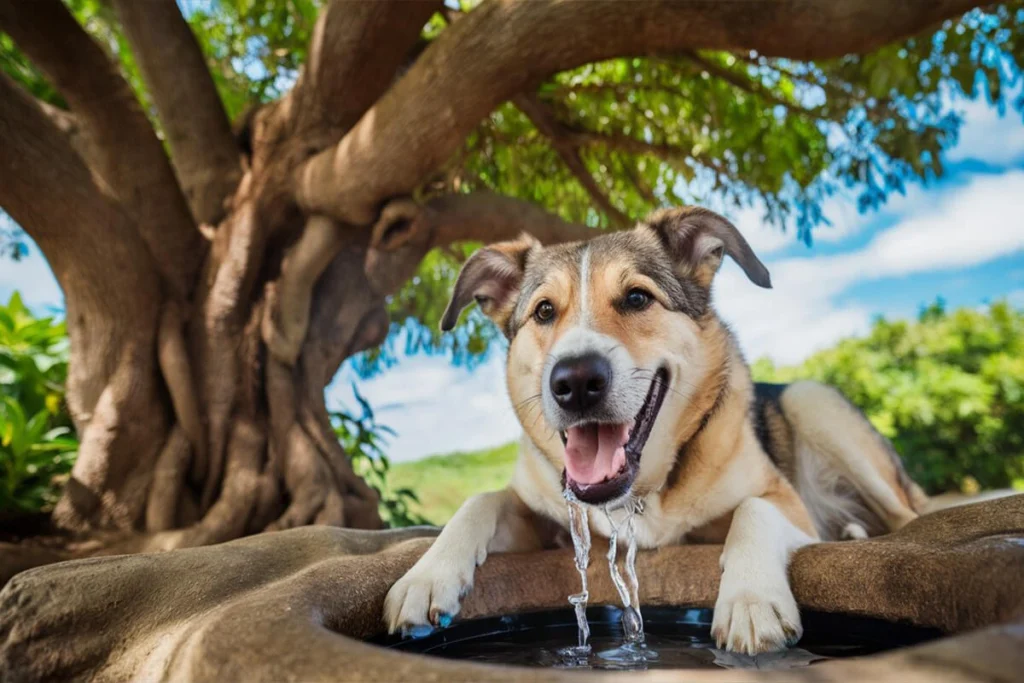
Ensuring Proper Hydration
- Always provide fresh, clean water in multiple locations around the home.
- Carry a portable water bowl when taking the dog on walks, hikes, or car rides.
- Encourage drinking by adding ice cubes or flavored water (low-sodium broth) if the dog seems reluctant to drink.
- Monitor hydration levels by checking the dog’s gums (they should be moist, not dry) and performing a skin elasticity test (gently pinch the skin—if it doesn’t snap back quickly, the dog may be dehydrated).
Preventing Overheating
- Limit outdoor activities during peak heat hours, especially in summer.
- Provide shady spots in the yard and keep the dog indoors when temperatures rise.
- Avoid hot pavement and asphalt, which can burn paws and increase body heat.
- Use cooling mats, fans, or air conditioning to help regulate body temperature.
- Never leave a dog in a parked car, even with the windows cracked—temperatures can rise dangerously fast.
By maintaining proper hydration and temperature control, pet owners can significantly reduce the risk of heatstroke and excessive panting, especially in hot weather.
Managing Anxiety and Stress
Anxiety and stress can cause rapid breathing, excessive panting, and even respiratory distress in dogs. Identifying triggers and taking proactive steps to reduce anxiety can improve a dog’s overall well-being.
Common Anxiety Triggers
- Loud noises (thunderstorms, fireworks, vacuum cleaners).
- Separation from their owner (separation anxiety).
- Changes in routine or environment (moving to a new home, new pets).
- Visits to the vet or groomer.
Ways to Reduce Stress and Anxiety
- Create a safe space where the dog can retreat when feeling anxious. A cozy crate, a quiet room, or a familiar blanket can provide comfort.
- Use calming techniques, such as gentle petting, soft music, or aromatherapy (lavender-scented diffusers).
- Establish a consistent routine for feeding, walking, and bedtime to create a sense of security.
- Provide mental stimulation, such as puzzle toys, training exercises, or interactive play, to keep the dog engaged and reduce nervous energy.
- Try behavioral training or desensitization techniques to help dogs gradually adjust to their triggers.
- Consider natural calming aids, such as vet-approved supplements, pheromone diffusers, or anxiety wraps (like a ThunderShirt).
If a dog’s anxiety becomes severe and persistent, consulting a veterinarian or a professional dog behaviorist can help determine if medication or specialized training is necessary.
Regular Vet Check-Ups to Monitor Heart and Respiratory Health
Routine veterinary visits play a critical role in detecting early signs of heart disease, respiratory issues, and other health conditions that cause heavy breathing. Many breathing-related illnesses, such as congestive heart failure, respiratory infections, or brachycephalic airway syndrome, develop gradually, making early diagnosis essential.
What Happens During a Vet Check-Up?
- The vet listens to the dog’s heart and lungs for abnormal sounds like murmurs, wheezing, or crackling noises.
- A respiratory rate assessment helps determine if the dog is breathing too fast or too shallow.
- The vet checks the dog’s gum color and oxygen levels, looking for pale, blue, or bright red gums.
- Blood tests, X-rays, or ultrasounds may be recommended if heart or lung disease is suspected.
How Often Should a Dog See the Vet?
- Puppies and senior dogs need check-ups every six months.
- Adult dogs in good health should visit the vet at least once a year.
- Dogs with existing heart or respiratory conditions require more frequent monitoring and possibly specialized care.
By staying proactive with regular vet visits, pet owners can catch health issues early, manage chronic conditions effectively, and ensure their dogs breathe easily and live healthier lives.
Conclusion
Recognizing when a dog is breathing heavy can help pet owners take quick action and prevent serious health complications. While occasional panting is normal, persistent heavy panting, labored breathing, or rapid breathing at rest can signal an underlying issue. Dogs may breathe heavily due to heatstroke, stress, allergies, heart disease, or respiratory infections, making it essential to understand the cause and respond appropriately.
Maintaining a dog’s respiratory health starts with proper hydration, temperature control, and stress management. Ensuring access to fresh water, keeping dogs cool in hot weather, and reducing anxiety can help prevent unnecessary heavy panting. Regular veterinary check-ups play a vital role in monitoring heart and lung health, catching potential issues before they become emergencies. If a dog’s breathing problems persist or worsen, seeking professional medical attention is always the safest choice.
Pet owners should learn to distinguish between normal panting and dog breathing heavy due to distress. Checking for emergency signs—such as blue gums, extreme fatigue, or wheezing—can help determine when to call the vet or rush to an emergency clinic. Quick action can save a dog’s life and prevent complications from oxygen deprivation or worsening medical conditions.
By understanding the causes of dog breathing heavy and taking preventive steps, pet owners can keep their furry companions healthy, comfortable, and safe. Whether the issue stems from overheating, medical conditions, or stress, early intervention makes a significant difference. Always stay attentive to a dog’s breathing patterns, provide proper care, and seek veterinary guidance when needed to ensure a long and happy life.
Discover a Lot more about Dogs and Breeds Here“
Find The Best Goods For your Pet on PetMD Official
